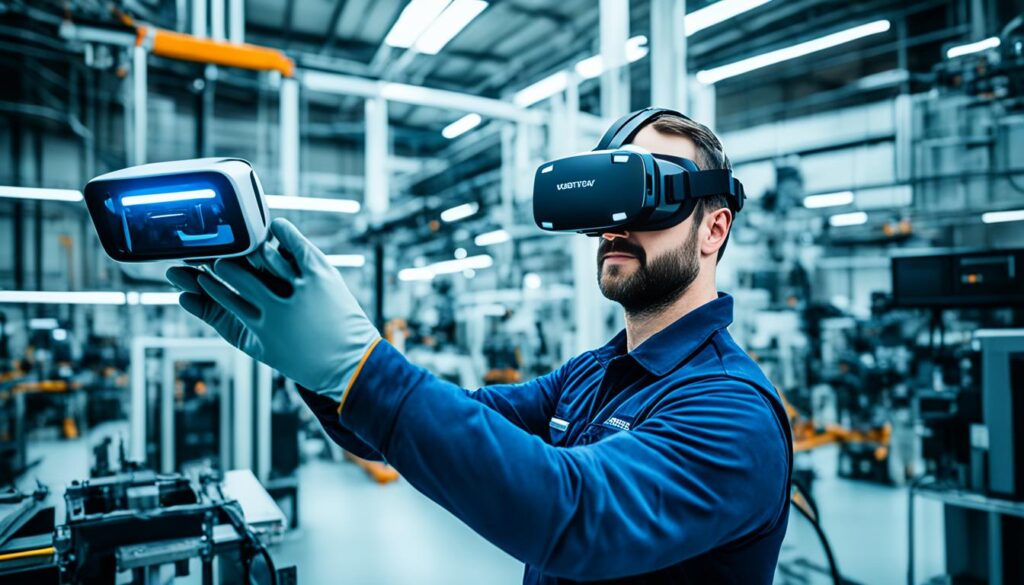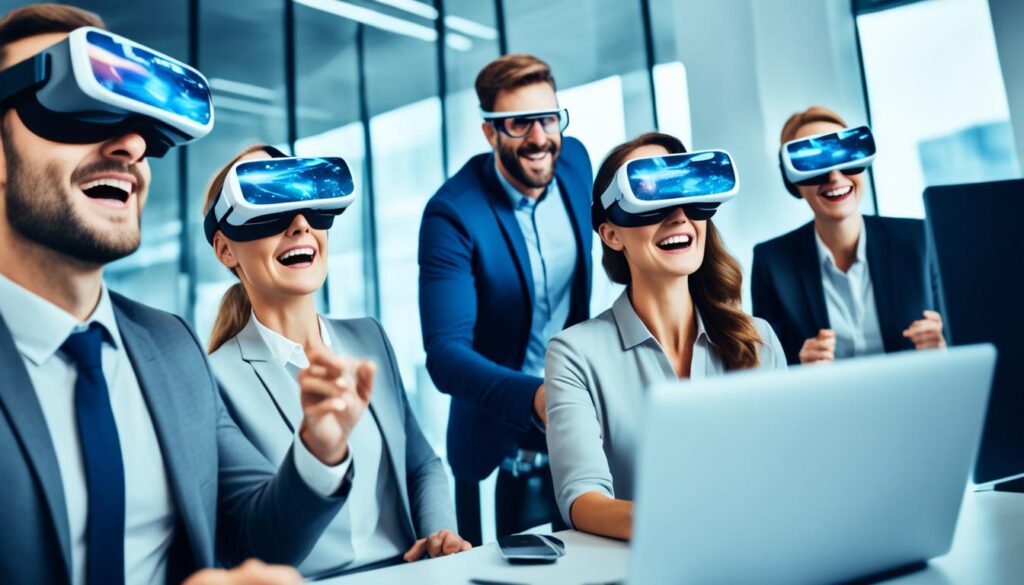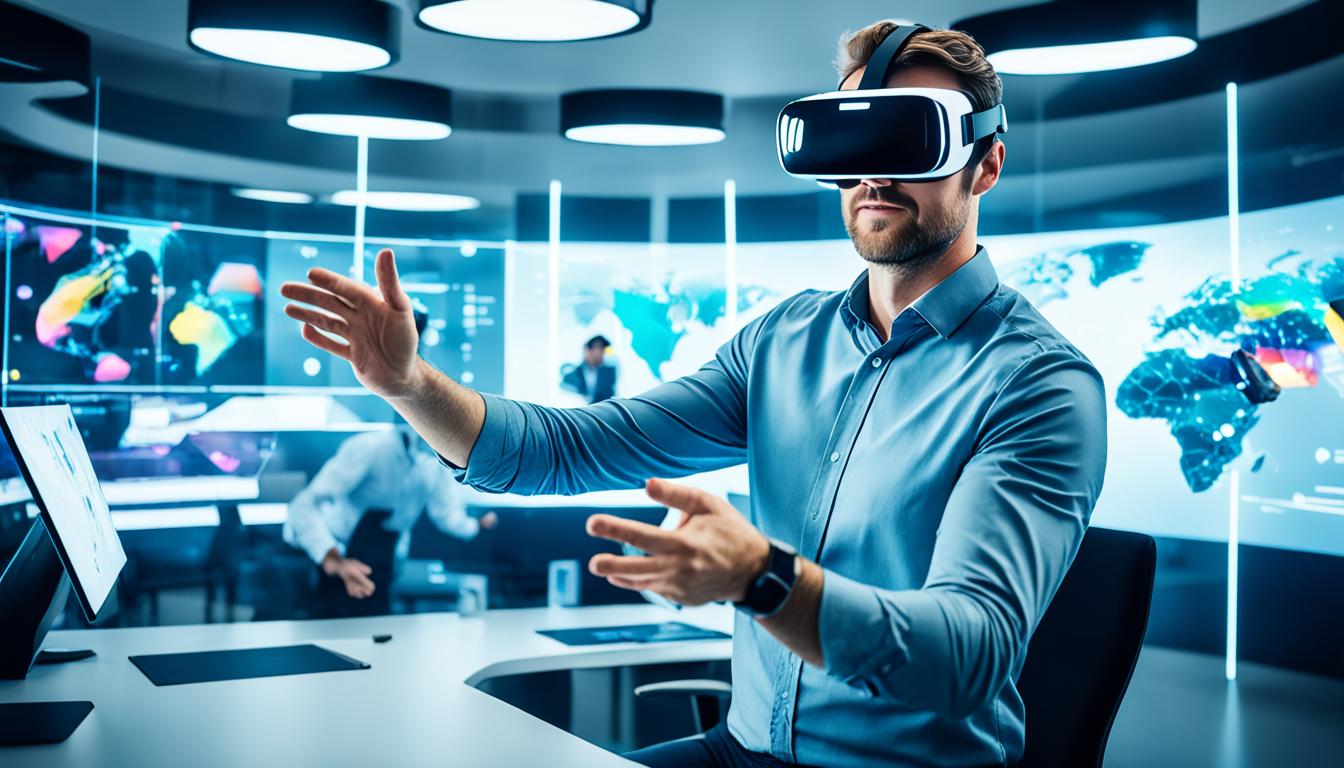Virtual reality (VR) is changing how businesses work by providing immersive experiences and creative ways to solve problems. It impacts sectors from helping people learn to engaging with customers and working with people worldwide. With VR, industries are seeing new possibilities.
Key Takeaways:
- Virtual reality (VR) technology is changing business operations significantly.
- VR introduces engaging experiences and novel solutions.
- It’s being utilized across sectors for training, engaging with customers, and collaborating globally.
- Industries adopting VR range from education and healthcare to gaming, retail, real estate, and automotive.
- Using VR in businesses brings benefits like saving money and improving customer interactions.
What is Virtual Reality (VR)?
Virtual reality, or VR, is a new technology that takes you into a three-dimensional digital world. It goes beyond normal screens, making you feel like you’re really there. You can see, touch, and interact with this new universe. This amazing tech is changing how we connect with reality.
With a VR headset, you enter a space that feels real but isn’t. This world can be made for games, learning, or work. It feels as if you’re really there, using all your senses. It makes the experience much more engaging.
How Does Virtual Reality Work?
Virtual reality uses special headsets, sensors, and screens to create a new world. The headset shows you this world, and sensors follow your movements. This lets you explore and interact with this digital space.
VR can be from simple videos to a whole new world that you can touch. The more advanced the VR tech, the more real the experience feels. You can visit ancient places, climb mountains, or train for real-life danger. It offers a wide range of fun and useful applications.
Virtual reality is transforming the way we perceive and interact with our surroundings. It has the power to transport us to places we’ve only dreamed of and offer experiences that were once unimaginable. The potential of VR technology is truly awe-inspiring.
As time goes on, VR will get even better and more real. It can take us to places we’ve never seen before. Virtual reality is setting the stage for a future where the real and digital worlds mix in surprising ways.
Virtual Reality in Business: The Exciting World of VR
Virtual reality (VR) is changing the game for businesses. It’s more than just a headset. It’s a technology that’s altering how we work, learn, and connect. By creating immersive experiences, VR is enhancing engagement and global teamwork.
VR has many uses, especially in training. It offers realistic experiences for employees to learn and practice. This reduces costs and improves their skills through repeated, safe virtual practice.
Virtual prototyping is changing how businesses create products and designs too. They can test and validate virtually before making physical versions. This saves time and money, and leads to better innovations.
For marketing, VR creates unique and captivating experiences. It puts customers into virtual worlds where they can interact with products closely. This gets their attention and leaves them with unforgettable memories.
VR is making global teamwork easier. It bridges the gap between far-away teams by offering real-time virtual environments. This boosts efficiency and spurs innovation across the globe.
VR is also great for data visualization. It turns complex data into accessible, interactive environments. This lets users explore data in a way that’s easier to understand, improving decision-making.
The Redefinition of Customer Experiences
VR is changing how customers experience products and services. It offers unique ways for them to engage, from shopping to test driving cars. This revolutionizes their interaction with brands.
Moreover, VR gives companies a chance to shine among their competitors. By adopting VR, businesses show they are innovative and forward-thinking. It strengthens their market position.
In the end, VR is opening up new possibilities for businesses. It’s redefining how we learn, market, and interact, both locally and globally. As more businesses incorporate VR, they’ll find new ways to succeed in the digital market.
Examples of Industries Using VR Technology
VR technology is changing many industries, introducing new ways of doing things. We will look at a few areas where VR has become very important.
Education
VR is changing the way we learn. It lets students visit important historical events or travel through space. This makes learning more fun and helps students remember things better.
Healthcare
Doctors are using VR to deal with pain. It also helps with training for surgeries and treating fears. With VR, doctors can practice surgeries, which makes them better at their job.
Gaming
For gamers, VR is making games more real. Now, players can feel like they’re in the game instead of just watching. This makes gaming very exciting and real for players.
Retail
In shops, VR lets you try on clothes without actually trying them on. This helps shoppers choose items they like more easily. It also means less returning stuff and happier customers.
Real Estate
In housing, VR shows homes to buyers without them needing to visit. This saves time and helps buyers see more homes. It makes selling homes easier for agents and better for buyers.
Automotive
Car companies are using VR to design cars and show them to customers. VR helps in making cars that people will love. You can test drive a virtual car before buying, which is very cool.

These industries show just some of the amazing ways VR is being used. As VR technology gets better, we will see even more cool uses in other areas too.
7 Companies Using VR in Their Organizations
Virtual reality (VR) technology is helping many companies get better at what they do. It’s also making employee training more effective. Here are some leading companies using VR:
1. Bank of America
Bank of America has upgraded its training programs with VR. Their use of VR makes learning service calls and account opening feel real. This approach offers employees true-to-life experiences.
2. Military and Police Departments
VR is now a key part of training for military and police forces. It lets personnel practice in risky and tense situations. This helps them get ready for actual events.
3. NASA
NASA uses VR to help astronauts train for space missions. This tech helps them face challenges they might encounter in space. It’s a powerful tool for getting astronauts ready.
4. Walmart
Walmart is using VR to train staff in sales and customer service. This method lets employees handle different customer needs in a virtual space. It boosts their confidence and skills.
5. LA Hospital and Uconn Health
LA Hospital and Uconn Health use VR for medical training. This includes surgical practice and patient diagnosis. It creates a realistic setting for professionals to improve their medical skills.
6. Automotive Companies (Audi, Volkswagen, BMW)
Top car makers like Audi, Volkswagen, and BMW use VR for safety training. It allows employees to go through safety steps in a virtual setup. This leads to a safer work environment.
Their use of VR doesn’t stop at training. Customers can also use VR to see and customize cars. It’s a unique shopping experience.
7. Other Industries
Many other industries are starting to use VR too. From education to real estate, VR is leading to new and immersive ways of doing things. It’s changing things for the better.
In the end, these companies highlight the many uses of VR today. It’s not just about training or selling cars. VR is pushing companies forward by changing how they work and connect with people.
Benefits of Implementing VR in Businesses
Adding VR to business brings lots of pluses. It helps with training and makes your brand stand out. It also saves money and makes customers happier. VR makes a business more innovative.
VR Training and Development
VR is great for training. It lets employees learn in a safe, real-feeling world. They can practice job skills without any risks. This boosts their confidence and job performance.
Brand Differentiation
VR sets your brand apart from the crowd. It gives customers unique, memorable experiences. Showing your innovation through VR can win over more customers. They’ll see your brand as creative and customer-focused.
Cost-Effectiveness
VR is a smart money choice for companies. It cuts costs on real-world demos and travel. Now, you can show products, give tours, and hold meetings virtually. This not only saves money but also simplifies planning.
Enhanced Customer Experiences
VR makes customer experiences better. It allows them to interact with products in amazing ways. Customers can see and try products like never before. This makes them happier with their choices and more loyal to your brand.

| Benefits of Implementing VR in Businesses |
|---|
| VR Training and Development |
| Brand Differentiation |
| Cost-Effectiveness |
| Enhanced Customer Experiences |
The State of VR in Companies
The VR market is growing fast, with future outlooks very positive. By 2025, experts think it could reach over $22 billion, showing a 50% increase. This jump comes from more industries, especially healthcare and education, using VR.
In healthcare, VR is changing how doctors and nurses learn and treat patients. They can now practice surgeries safely with VR. VR also helps in pain relief, making recovery easier for patients.
Education is also using VR to make learning better. Students can visit historic places or explore science in VR. This makes learning fun and memorable. Plus, they can practice real-world skills in a safe setting.
VR is making big changes in how we work and learn. It’s making things in healthcare and education better. This technology is on track to be big, offering new chances for many sectors.
| Industry | VR Applications |
|---|---|
| Healthcare | – Training and skill development – Surgical simulations – Pain management and therapy – Virtual patient experiences and diagnostics |
| Education | – Immersive learning experiences – Historical simulations – Scientific and engineering explorations – Skill development and training |
Advantages of Virtual Reality in Business
Virtual reality (VR) has many benefits for businesses. It allows companies to explore new opportunities. They can also improve how they work in different ways.
Reducing Travel Costs and Remote Inspections
VR helps cut down on the cost of traveling for business. It lets employees take part in events virtually, making physical visits unnecessary. This saves money and avoids the need for everyone to be at the same place.
Virtual Tours for Customers
Virtual tours are a big plus of VR. They let customers visit places without actually going there. This is great for real estate, hotels, and tourist sites. People can see these places before visiting, which can lead to more sales.
Enhanced Safety Training through Immersive Simulations
VR makes safety training better by creating lifelike scenarios. Employees can practice important safety skills in a risk-free way. This is key for jobs where safety is crucial, like in construction. It helps prevent accidents and improves how ready people are for emergencies.
Collaboration and Productivity
VR also boosts how teams work together. It allows for virtual meetings and teamwork. This can really help global companies with teams all over the world. It makes sharing ideas and making decisions easier and more productive.
Enhanced Customer Service and Increased Sales
Using VR can make customer service better. It’s great for retail, putting customers in virtual showrooms. It can also be used in auto sales for virtual test drives. This kind of experience makes customers happier and more likely to buy.
Improved Brand Trust
VR can also help a brand look more trustworthy. Businesses that use VR come off as modern and focused on customers. This can help people trust and like the brand more.
In conclusion, VR changes how businesses work by cutting travel costs, providing immersive experiences, and making training better. It improves collaboration, customer service, and brand trust. By using VR, companies can stand out in their market. They can find new ways to grow and lead in their field.
Pros and Cons of Virtual Reality in Business
Businesses can benefit from using virtual reality (VR) technology, but there are also drawbacks. Here are the pros and cons:
Pros of VR in Business
Effective Communication: VR makes it easier for businesses to share ideas and data. It creates immersive experiences for users. Team members can join interactive presentations and meetings. This improves teamwork and understanding.
Immersive Experiences: VR offers a unique, immersive experience. It surpasses traditional ways of communication. Businesses can engage their customers with captivating experiences. This leads to greater customer satisfaction and loyalty.
Detailed Views: Through VR, businesses can present their products and services in vivid detail. It lets customers virtually interact with offerings. This allows for a realistic experience before purchasing.
Cons of VR in Business
High Cost: Setting up VR can be pricey, especially for small companies. The cost includes hardware, software, and upkeep. For some, this investment might be too big.
Addiction: Being deeply immersive, VR carries a risk of addiction. It’s vital to avoid overuse, as it can negatively affect work and mental health. Setting usage rules and monitoring is key.
Early Stages of Development: VR is still growing as a technology. This means new features and improvements are always happening. Companies need to stay informed about these changes.
VR can revolutionize how businesses communicate, create experiences, and present products. Yet, its costs, addiction potential, and ongoing development must be carefully considered.
Conclusion
Virtual reality is changing the game in business, offering new ways to train, market, and work together. Its immersive features help companies find unique solutions and improve how they work.
With the VR market quickly expanding, businesses have a big opportunity. Immersive VR can help them stand out and lead in the digital world. By using virtual reality, companies can change how they train, interact with customers, and work globally.
The future for VR in business looks very bright. As technology gets better and more people can access VR, we’ll see amazing new uses. VR will keep changing different fields, letting businesses make memorable experiences and find new ways to use products and data. It’s a thrilling time for virtual reality. Those who adopt this powerful technology early will lead the way in our changing digital world.
FAQ
How can virtual reality (VR) be used in business?
Virtual reality changes business in many ways. It’s used for training, making new products, marketing, and even global teamwork. It helps show data better and makes customers’ experiences more fun and engaging.
What is virtual reality (VR)?
Virtual reality takes you to digital worlds. It’s a high-tech experience. Users feel like they’re really there and can interact with the virtual environment.
How is virtual reality transforming industries?
VR is changing how different fields work and learn through tech and new experiences. It’s redesigning customer experience and making global teamwork easier.
Which industries are using VR technology?
Many fields use VR, like schools, hospitals, games, shops, and car makers. It’s used for learning, health, trying on clothes, touring homes, and designing cars.
Can you provide examples of companies using VR?
Several big companies are already using VR. Bank of America and Walmart train employees with it. The military, NASA, and health centers use it for risky and medical training. And car makers like Audi and BMW use it to teach about safety and give virtual shopping experiences.
What are the benefits of implementing VR in businesses?
VR makes training safer and more fun. It makes your brand look innovative and saves money on real models and travel. Plus, it makes meeting customers in your virtual world exciting.
What is the state of virtual reality in companies?
The VR industry is growing fast. It’s making a lot of money and being used more in fields like health and learning. VR is changing how we do things and giving new experiences.
What are the advantages of virtual reality in business?
There are plenty of good things about VR in business. It saves money on travel and lets clients see places with virtual tours. It makes safety training more real and improves how teams work together.
What are the pros and cons of virtual reality in business?
VR has many benefits like immersive experiences and rich details. Still, it’s costly and can lead to addiction without fuller development. So, it has both good and bad points.
What is the future of virtual reality in business?
The future of VR in business looks bright. It will offer new ways to train, market, work together, and wow customers. Companies need to get into VR to grow and lead digitally.



















